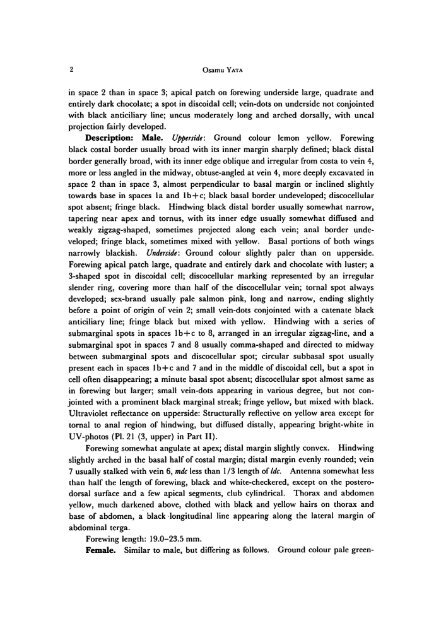A Revision of the Old World Species (Lepidoptera, Pieridae)
A Revision of the Old World Species (Lepidoptera, Pieridae)
A Revision of the Old World Species (Lepidoptera, Pieridae)
You also want an ePaper? Increase the reach of your titles
YUMPU automatically turns print PDFs into web optimized ePapers that Google loves.
2 Osamu Yata<br />
in space 2 than in space 3; apical patch on forewing underside large, quadrate and<br />
entirely dark chocolate; a spot in discoidal cell; vein-dots on underside not conjointed<br />
with black anticiliary line; uncus moderately long and arched dorsally, with uncal<br />
projection fairly developed.<br />
Description: Male. Upperside'. Ground colour lemon yellow. Forewing<br />
black costal border usually broad with its inner margin sharply defined; black distal<br />
border generally broad, with its inner edge oblique and irregular from costa to vein 4,<br />
more or less angled in <strong>the</strong> midway, obtuse-angled at vein 4, more deeply excavated in<br />
space 2 than in space 3, almost perpendicular to basal margin or inclined slightly<br />
towards base in spaces la and lb+c; black basal border undeveloped; discocellular<br />
spot absent; fringe black. Hindwing black distal border usually somewhat narrow,<br />
tapering near apex and tornus, with its inner edge usually somewhat diffused and<br />
weakly zigzag-shaped, sometimes projected along each vein; anal border unde<br />
veloped; fringe black, sometimes mixed with yellow. Basal portions <strong>of</strong> both wings<br />
narrowly blackish. Underside'. Ground colour slightly paler than on upperside.<br />
Forewing apical patch large, quadrate and entirely dark and chocolate with luster; a<br />
3-shaped spot in discoidal cell; discocellular marking represented by an irregular<br />
slender ring, covering more than half <strong>of</strong> <strong>the</strong> discocellular vein; tornal spot always<br />
developed; sex-brand usually pale salmon pink, long and narrow, ending slightly<br />
before a point <strong>of</strong> origin <strong>of</strong> vein 2; small vein-dots conjointed with a catenate black<br />
anticiliary line; fringe black but mixed with yellow. Hindwing with a series <strong>of</strong><br />
submarginal spots in spaces lb+c to 8, arranged in an irregular zigzag-line, and a<br />
submarginal spot in spaces 7 and 8 usually comma-shaped and directed to midway<br />
between submarginal spots and discocellular spot; circular subbasal spot usually<br />
present each in spaces lb+ c and 7 and in <strong>the</strong> middle <strong>of</strong> discoidal cell, but a spot in<br />
cell <strong>of</strong>ten disappearing; a minute basal spot absent; discocellular spot almost same as<br />
in forewing but larger; small vein-dots appearing in various degree, but not con<br />
jointed with a prominent black marginal streak; fringe yellow, but mixed with black.<br />
Ultraviolet reflectance on upperside: Structurally reflective on yellow area except for<br />
tornal to anal region <strong>of</strong> hindwing, but diffused distally, appearing bright-white in<br />
UV-photos (PI. 21 (3, upper) in Part II).<br />
Forewing somewhat angulate at apex; distal margin slightly convex. Hindwing<br />
slightly arched in <strong>the</strong> basal half <strong>of</strong> costal margin; distal margin evenly rounded; vein<br />
7 usually stalked with vein 6, mdc less than 1/3 length <strong>of</strong> Idc. Antenna somewhat less<br />
than half <strong>the</strong> length <strong>of</strong> forewing, black and white-checkered, except on <strong>the</strong> posterodorsal<br />
surface and a few apical segments, club cylindrical. Thorax and abdomen<br />
yellow, much darkened above, clo<strong>the</strong>d with black and yellow hairs on thorax and<br />
base <strong>of</strong> abdomen, a black longitudinal line appearing along <strong>the</strong> lateral margin <strong>of</strong><br />
abdominal terga.<br />
Forewing length: 19.0-23.5 mm.<br />
Female. Similar to male, but differing as follows. Ground colour pale green-
















